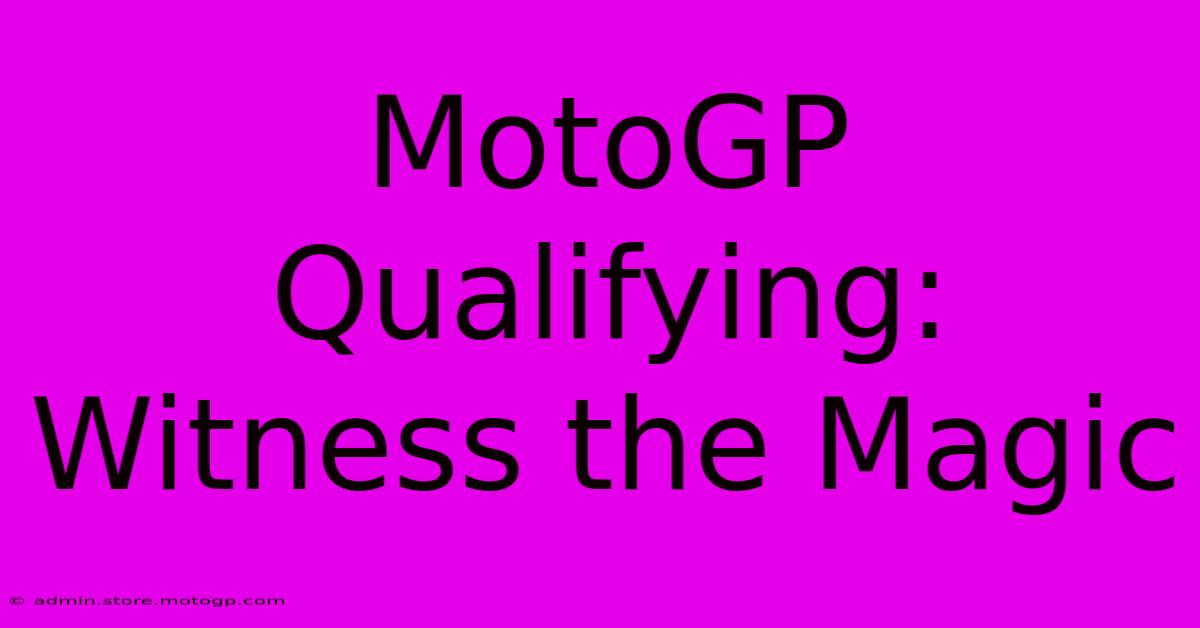MotoGP Qualifying: Witness The Magic

Table of Contents
MotoGP Qualifying: Witness the Magic
MotoGP qualifying. The words themselves conjure images of screaming engines, tire smoke, and the sheer audacity of riders pushing their machines – and themselves – to the absolute limit. It's a spectacle unlike any other in motorsport, a breathtaking display of skill, strategy, and nerve that decides the all-important starting grid for the race. This article delves into the magic of MotoGP qualifying, exploring its intricacies and the drama that unfolds every weekend.
Understanding the Qualifying Format
The current MotoGP qualifying format is a multi-stage process designed to maximize excitement and ensure the fastest riders are rewarded with prime grid positions. It's a crucial element that significantly impacts the race outcome.
Q1: The Battle for Q2
The session begins with Q1, where the slowest ten riders from the combined Free Practice times battle it out for a place in the coveted Q2. This initial phase is often packed with intense overtaking maneuvers and last-gasp efforts to secure a top-two finish – the only way to progress to the next stage. The pressure is immense, and mistakes can be incredibly costly. This part of qualifying showcases the raw speed and resilience of the riders.
Q2: The Fight for Pole Position
Q2 features the fastest sixteen riders from FP3 combined with the top two from Q1. This is where the real fireworks start. Here, the top MotoGP stars fight tooth and nail for pole position, the ultimate accolade and a significant advantage come race day. The tension is palpable; every tenth of a second counts, and even the slightest slip-up can mean the difference between securing the front row and starting further down the grid.
The Art and Science of Qualifying
MotoGP qualifying isn't just about raw speed; it's a complex dance of strategy and precision. Teams meticulously analyze track conditions, tire wear, and weather forecasts to optimize their riders' qualifying runs.
Tire Management: A Crucial Factor
Tire choice and management are critical. Riders must balance pushing to the absolute limit with preserving their tires for the race, a delicate balancing act demanding years of experience and finely honed instincts. A wrong tire choice or overzealous riding can ruin a qualifying session, severely hindering race day performance.
Slipstreaming and Teamwork: The Strategic Advantage
Slipstreaming plays a vital role. Riders use the air disruption created by a leading bike to gain a crucial speed boost, often making the difference between a top-ten finish and missing out entirely. Teamwork also contributes; teams often strategize to ensure one rider helps the other during their qualifying runs.
Beyond the Numbers: The Human Element
While qualifying involves intricate calculations and technical expertise, the human element remains paramount. The pressure of performing under intense scrutiny, the physical and mental demands of pushing the limits of human endurance – these factors are as crucial as technical know-how. The courage, concentration, and skill displayed are a compelling testament to the human spirit.
The Excitement of Qualifying: More Than Just a Warm-Up
MotoGP qualifying is not simply a precursor to the race; it's a dramatic spectacle in itself. The roar of the engines, the breathtaking speed, and the palpable tension create an atmosphere unlike any other. It's a display of raw power and human skill that sets the stage for the race itself, influencing strategy, overtaking opportunities, and the final outcome. Witnessing MotoGP qualifying is to witness the magic of motorsport at its finest. Don't miss it!
Keyword Optimization & SEO Considerations:
This article incorporates several SEO strategies:
- Keyword Density: Keywords like "MotoGP qualifying," "pole position," "Q1," "Q2," "tire management," "slipstreaming," "race strategy" are naturally integrated throughout the text.
- Long-Tail Keywords: Phrases like "MotoGP qualifying format," "the art and science of qualifying," "the excitement of qualifying" are used to target more specific searches.
- Header Tags (H2, H3): Structure is improved using header tags to organize the content logically and improve readability for both users and search engines.
- Bold and Strong Tags: Key phrases are emphasized using bold and strong tags to highlight important information.
- Readability: The article is written in a clear, concise style, ensuring readability and user engagement.
This approach aims to improve the article's search engine ranking and attract a wider audience interested in MotoGP qualifying.

Thank you for visiting our website wich cover about MotoGP Qualifying: Witness The Magic. We hope the information provided has been useful to you. Feel free to contact us if you have any questions or need further assistance. See you next time and dont miss to bookmark.
Featured Posts
-
The Unsung Heroes Of Moto Gp The Announcers
Feb 18, 2025
-
Moto Gp Bike Costs Unveiled
Feb 18, 2025
-
Go Behind The Scenes Of Moto Gp With Tnt Sports
Feb 18, 2025
-
Yamaha Moto Gp News What You Need To Know
Feb 18, 2025
-
Lot R The Cota Parking Solution
Feb 18, 2025
